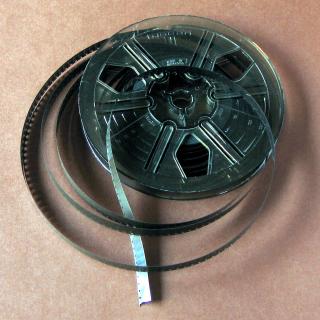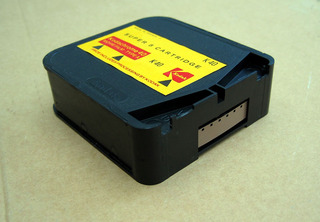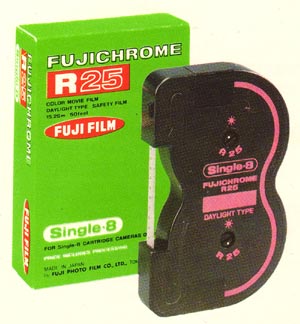
“8 mm” film simply describes the width of the film that goes through the projector. It's a vague description, and is confusingly used to describe different types of film with quite different properties. We can handle various types of 8 & 16 mm film, but if you want an estimate of the cost of copying your film to video, we need to know what type of film you have, as different types of film will fit different lengths on the same diameter spools. This page details the types of film that I can handle, and their running times.
As a quick guide, you can tell Standard 8 apart from Super 8, by looking at the sprocket holes: Standard 8 has larger sprocket holes than Super 8. And Standard 8 fits the pictures between the sprocket holes, whereas Super 8 has them lined up with the centre of the picture. Alternatively, if you can remember how you used to use your camera, Standard 8 used bare spools, and you flipped them over to use the film in two directions, whereas Super 8 came in a plastic cartridge that only fitted one way into the camera (pictured below). Single 8 looks like Super 8, but is made from a thinner film.
For 8 mm film-to-video, we run the films at sixteen and two-thirds frames per second, so they don't strobe madly on the Australian twenty-five frames per second television system. These two rates are mathematically related, to show one-and-a-half film frames per television frame, with almost no noticeable flicker. This is slightly different from the speed the film was shot at, usually eighteen frames per second, so the action may appear slightly slower.
Our 16 mm projector runs at the normal twenty-four frames per second film speed, and this works fine without any objectionable strobing effects.
When we do film to video transfers, we charge based on the running time of the film. The following tables will allow you to estimate how much a job will cost. The longer spool length estimations are based around the average lengths of several small films joined together, minus a few little bits (most people join together just the parts that they want, rather than the entire film, which often includes mistakes and blank sections). All the measurements are approximate.
We can handle individual films on the small 3 inch spools, up to the 7 inch size. If you're going to splice several films onto a larger spool, do not fill the spool right up to the edge.
Standard/Double/Regular 8 movie film
| Spool size | Running time | |
|---|---|---|
| Diameter | Length | |
| 3 inch 7·4 cm |
50 foot 15 metre |
4–5 minutes |
| 5 inch 12·6 cm |
200 foot 60 metre |
approx 17 minutes |
| 7 inch 18 cm |
400 foot 120 metre |
approx 35 minutes |
Standard 8 was the first 8 mm width movie film, it was brought out before Super 8 even existed. Originally called “Cine Kodak Eight,” it's also known as “Regular 8,” (a later name to distinguish it from Super 8), some people call it “Cine 8,” (abbreviating its original name), and it's known as “Double 8,” thanks to the way that the film is loaded in the camera:
Double 8 film starts off as 16 mm width film that you ran through the camera exposing half the width of the film, then flipped over and ran through the camera again, and exposing the other half of the film. The developing lab split the exposed film down the middle, then joined the two halves, end-to-end, for you to project as a double-the-original-length 8 mm wide film. Thus, a 25 foot spool of (16 mm wide) camera film became a 50 foot spool of (8 mm wide) projection film.
Chances are that if you kept the film in the original box, what you think is a 25 foot film (because of the box's labelling), is actually a 50 foot film, and will run for twice as long as you think. If the 3 inch spool is nearly full, it's a 50 foot film. Smaller amounts are harder to guage; you'd have to know its originals, whether it's half a spool, or the sliced off remnants of a larger amount. Thankfully, most of the larger spools have markings on them that will tell you the length of film that they're holding.
You might think it would have been more practical to label the film boxes by the length of running time, but that has confusing variations, too: Most home movies run at 18 frames per second, but some run at 24 frames per second, and there were some other speeds, as well. The same physical length of film would last for different amounts of time, depending on how you shot it. So the manufacturers take the easy route (for them), and tell you the physical length of film, and let you work out how long it will run for, according to how you used it.
I've yet to encounter a Standard 8 film with sound, but it is possible for them to have a sound stripe.
Super 8 movie film

| Spool size | Running time | |
|---|---|---|
| Diameter | Length | |
| 3 inch 7·4 cm |
50 foot 15 metre |
3–4 minutes |
| 5 inch 12·6 cm |
200 foot 60 metre |
approx 15 minutes |
| 7 inch 18 cm |
400 foot 120 metre |
approx 26–30 minutes |
Single and Super 8 films were inserted into the camera using a cartridge system that loaded an 8 mm width film into the camera. Fuji made the Single 8 cartridge, it was a two reels in a cartridge that could be wound in either direction, allowing for special effects. Kodak made Super 8, with one spool in a cartridge that could only run the film in one direction. For both types, lab processing involved removing the film from the cartridge, developing, and returning the same film on a small three-inch spool.
Super 8 has smaller sprocket holes than Standard 8, allowing the picture size between them to be bigger, and therefore provide better picture quality. However, over all the years that I've been doing film to video transfers, I've generally found the Standard 8 films to have better picture quality.
Because of the different sprocket and picture sizing, you can only project Super 8 or Standard 8 films in the right types of projector—either one dedicated to the particular format, or a dual-standard projector.
Super 8 can have one or two magnetic sound tracks—usually seen as a brown strip on the opposite side from the sprocket holes, or on both edges of the film when there's two tracks). We have one projector that can play back sound. If you have sound on any of your films, make sure that we know about it, as we often use the silent projector for film transfer work.
Single 8 movie film

This film has the same width and sprocket dimensions as Super 8, but is thinner film. Therefore the running times, for the same diameter spools will be longer, as more film will fit into the same space on the spool (I don't have a table of lengths and running times for Single 8 spools). But length-wise, the running times will be the same as Super 8 film. Projection-wise, Single 8 and Super 8 are compatible with each other, though thinner films can be a problem with some projectors.
| Spool size | Running time | |
|---|---|---|
| Diameter | Length | |
| 7 inch 18 cm |
590 foot 180 metre |
approx 40–45 minutes (estimated) |
16 mm movie film
| Spool size | Running time | |
|---|---|---|
| Diameter | Length | |
| 100 foot 30 metre |
approx 3 minutes | |
| 400 foot 122 metre |
approx 11 minutes | |
| 1000 foot 300 metre |
approx 30 minutes | |
| 12 inch 31 cm |
1200 foot 366 metre |
approx 36 minutes |
| 14 inch 35 cm |
1600 foot 480 metre |
approx 48 minutes |
i.e. Approx 10 metres per minute.
16 mm films can have magnetic or optical sound tracks. It's more usual for them to have optical sound tracks on distribution films, with magnetic tracks being used within a production facility. Our projector can only play back optical sound, if yours has magnetic sound we borrow one from a colleague, and this increases the turnaround time to finish the job.